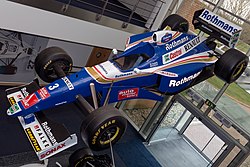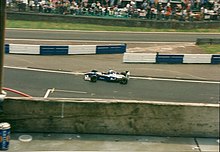Williams FW19
 | |||||||||||
| Category | Formula One | ||||||||||
|---|---|---|---|---|---|---|---|---|---|---|---|
| Constructor | Williams | ||||||||||
| Designer(s) | Patrick Head (Technical Director) Adrian Newey (Chief Designer) Geoff Willis (Chief Aerodynamicist) | ||||||||||
| Predecessor | Williams FW18 | ||||||||||
| Successor | Williams FW20 | ||||||||||
| Technical specifications | |||||||||||
| Chassis | Carbon-fibre and honeycomb composite structure | ||||||||||
| Suspension (front) | Williams inboard torsion bar, double wishbone, operated by a push-rod bellcrank | ||||||||||
| Suspension (rear) | Williams inboard coil-spring/double wishbone, operated by a push-rod bellcrank | ||||||||||
| Engine | Renault RS9, RS9A and RS9B 3.0-litre V10 (71°), naturally-aspirated, mid-engined | ||||||||||
| Transmission | Williams/Komatsu 6-speed transverse sequential semi-automatic | ||||||||||
| Power | 740–760 hp (552–567 kW; 750–771 PS) @ 16,000 rpm | ||||||||||
| Fuel | Elf | ||||||||||
| Lubricants | Castrol | ||||||||||
| Tyres | Goodyear | ||||||||||
| Competition history | |||||||||||
| Notable entrants | Rothmans Williams Renault | ||||||||||
| Notable drivers | 3. 4. | ||||||||||
| Debut | 1997 Australian Grand Prix | ||||||||||
| |||||||||||
| Constructors' Championships | 1 (1997) | ||||||||||
| Drivers' Championships | 1 (1997, Jacques Villeneuve) | ||||||||||
The Williams FW19 was the car with which the Williams team competed in the 1997 Formula One World Championship. It was driven by Jacques Villeneuve, in his second year with the team, and Heinz-Harald Frentzen, who moved from Sauber to replace the dropped 1996 champion, Damon Hill. Williams also employed test drivers Jean-Christophe Boullion and Juan Pablo Montoya.
The car was a logical development of the extremely successful FW18, which had comfortably won both titles in 1996. It was also the last Williams chassis to receive input from designer Adrian Newey, who left the team to join McLaren before the season began. His work was finished by Geoff Willis. The FW19 was the last Williams to run a works Renault engine before the French marque's temporary withdrawal. It also benefited from design input from Patrick Head. The new car was designed to be lighter and stiffer than the FW18.[1]
However, 1997 was more difficult for Williams, as they faced a tough, season-long challenge from Michael Schumacher and Ferrari. After a controversial collision between Villeneuve and Schumacher in the season finale at Jerez, the Canadian took the Drivers' Championship, with the team claiming the Constructors' Championship at the previous race in Japan. Frentzen, by contrast, had a disappointing year, winning only one race to Villeneuve's seven. However, he did finish second in the Drivers' Championship due to Schumacher's exclusion from the standings.
Villeneuve later said that the FW19 was his favourite Formula One car, but that it was difficult to drive and get the maximum out of. He added that it felt like driving on ice for much of the time.[2] Frentzen also found the car difficult to drive, and struggled setting it up to his liking all season.[citation needed]
The team eventually scored 123 points to win the Constructors' Championship.
The car was the last Williams to use the highly successful naturally aspirated Renault RS9 V10 engine along with the in-house Williams gearbox.[citation needed] The car used Elf fuel, Castrol oil, Penske shock absorbers and AP Racing carbon disc brakes.[citation needed]
To this date, the FW19 remains the last Williams car to win either championship.[citation needed]
1997 season
The car had the tough challenge of picking up the baton from 1996's FW18, which had walked away with both titles in the hands of Damon Hill, now departed for Arrows, and the retained Jacques Villeneuve.
The season began in the way 1996 left off for Williams, with Villeneuve taking pole and Frentzen joining him on the front row for the opening race in Australia. Villeneuve was in trouble right from the start, however, and a bad start pulled him back into the field and he was taken out by Johnny Herbert in the Sauber. This left Frentzen in the lead, but he was jumped by David Coulthard's McLaren in the second pitstops. He was still on for second place, however, but his brakes failed three laps from the end and it was a no score for Williams.

Villeneuve took pole again in Brazil, with Frentzen down in a disappointing 8th. Villeneuve held the lead for the entire race apart from three laps during the second round of pitstops and held on to take his and Williams's first win of the season. Frentzen, however, had a far more exciting race, dropping to 13th at the start, being passed by Hill, Ralf Schumacher in the Jordan, Rubens Barrichello's Stewart, Coulthard and Herbert. He repassed Barrichello and Herbert in the early laps, but remained in 11th after the first stops. The second stops were better for him, and he passed Ralf Schumacher, Hill and Coulthard, emerging in 8th. He was passed late on by Giancarlo Fisichella in the Jordan and demoted to 9th, so once again scored no points. This result left Villeneuve equal top of the championship with Coulthard and Williams equal second with Benetton and behind McLaren.
An early safety car was triggered in Argentina due to the collision between Coulthard and Ferrari's Michael Schumacher. This was good for the Williams team, who had started 1-2, with Villeneuve on pole for the third consecutive time. It didn't last very long for Frentzen, though, as his clutch broke after only five laps, meaning he had still scored no points for the season. Villeneuve was able to hold on to the lead for the vast majority of the race, with only five laps during the pitstops led by the Ferrari of Eddie Irvine. The Canadian's second win of the season left him and the team clear at the top of the championship table, despite Frentzen being yet to score.
The Grove based team locked out the front row yet again in San Marino, and Villeneuve retained his 100% pole position record for 1997. Frentzen was jumped by Michael Schumacher at the start, and the Williams cars ran 1st and 3rd until the first round of pitstops, when Villeneuve was already suffering from gearbox problems. Frentzen jumped his compatriot Schumacher and took the lead while Villeneuve dropped to 3rd with his problems. He finally retired on lap 41. Frentzen was under pressure from Schumacher to the very end, but held on to take his first ever F1 victory. Villeneuve held on to his championship lead, as did the team, and Frentzen moved up to equal third — he, Gerhard Berger of Benetton, Mika Häkkinen of McLaren, Irvine and Coulthard all had 10 points.
Frentzen took his first career pole at the Monaco Grand Prix, but Villeneuve was back in third with Michael Schumacher splitting them. The Ferrari man jumped Frentzen at the very wet start and the Jordans of Fisichella and Ralf Schumacher also got through. Villeneuve had an awful start and was down to 9th, behind Coulthard, Herbert, Barrichello and Olivier Panis's Prost as well. Frentzen had a spin and Villeneuve had technical problems, and they were soon running 16th and 17th. As the rain continued to fall, they picked up places due to the accidents of Herbert and Jarno Trulli in the Minardi, Berger having to stop for a new front wing and actually passing Shinji Nakano's Prost on the racetrack. This left them in 11th and 12th with Frentzen still leading his teammate, but on lap 17 Villeneuve pulled into the pits with a problem, later identified as accident damage after a brush with the barrier, and retired. Frentzen picked up a place on the same lap due to Jean Alesi spinning his Benetton out of the race. The German passed Ukyo Katayama in the other Minardi a lap later, and was in 9th. He was still in 9th on lap 40 when he ran wide at the seafront chicane and bounced across the kerbs, damaging his right front suspension. He then hit the wall on the other side of the track, which caused almost identical damage to the left front suspension. He was out of the race, and the Williams Monaco challenge was over. Michael Schumacher's victory left him top of the championship by four points from Villeneuve. Frentzen had been demoted to fourth due to Eddie Irvine's 3rd place, and Williams had been bumped down to 2nd by the Ferrari performance.
The Williams cars were back on the front row in Spain, with Villeneuve on pole again. Villeneuve held position at the start despite intense pressure from Coulthard and Michael Schumacher. Frentzen, however, dropped down to 6th as the McLaren and the Ferrari swept passed him along with Alesi and Häkkinen. Frentzen had run as high as third, but by the time the second pitstops were over he was down to 8th - Herbert and Panis had got passed him as well. At the end Villeneuve was able to hold onto the lead only because Olivier Panis, an unlikely challenger, was caught in the traffic of Eddie Irvine and Jos Verstappen's Tyrrell. Frentzen was not much help to the Canadian, only moving up to 8th with a last lap move on Fisichella. This result allowed Villeneuve to move back to the lead of the championship, but meanwhile Frentzen was slipping, from 4th to 6th as Panis and Coulthard overtook him.[3]
Complete Formula One results
(key) (results in bold indicate pole position; results in italics indicate fastest lap)
| Year | Team | Engine | Tyres | Drivers | 1 | 2 | 3 | 4 | 5 | 6 | 7 | 8 | 9 | 10 | 11 | 12 | 13 | 14 | 15 | 16 | 17 | Points | WCC |
|---|---|---|---|---|---|---|---|---|---|---|---|---|---|---|---|---|---|---|---|---|---|---|---|
| 1997 | Williams | Renault V10 | G | AUS | BRA | ARG | SMR | MON | ESP | CAN | FRA | GBR | GER | HUN | BEL | ITA | AUT | LUX | JPN | EUR | 123 | 1st | |
| Jacques Villeneuve | Ret | 1 | 1 | Ret | Ret | 1 | Ret | 4 | 1 | Ret | 1 | 5 | 5 | 1 | 1 | DSQ | 3 | ||||||
| Heinz-Harald Frentzen | 8 | 9 | Ret | 1 | Ret | 8 | 4 | 2 | Ret | Ret | Ret | 3 | 3 | 3 | 3 | 2 | 6 |
References
- AUTOCOURSE 1997-98, Henry, Alan (ed.), Hazleton Publishing Ltd. (1997) ISBN 1-874557-47-0
- ^ "Williams FW19". www.f1technical.net. Retrieved 30 January 2020.
- ^ "Great racing cars: Williams FW18 and FW19". Motor Sport Magazine. 19 October 2015. Retrieved 30 January 2020.
- ^ "The FW19 marked the end of an era for Williams and Renault | GRR". www.goodwood.com. Retrieved 30 January 2020.

